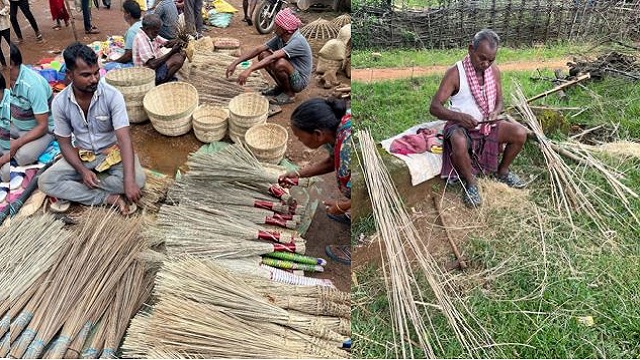Bamboo, lifeline of tribal craftsmanship and culture of Odisha
During the ongoing research, the Team found that unlike the crucial MFPs like Mahua, Sal seed, chironjee, Kendu leaf, ‘Bamboo’ – is a key MFP which is continues to play a central role in the daily lives and economy of tribal communities in Odisha, sustaining traditional craftsmanship and providing environmentally friendly alternatives to synthetic products.
By: Kondalu Sarathi
The Tribal Research Wing of the Government of Odisha, SCSTRTI Bhubaneswar, is conducting a paramount research project on “Minor Forest Products (MFP), across the 14 TSP (Tribal Sub-Plan) districts of Odisha”.
The project aims to assess the availability and potential of MFPs, investigate the dependency of tribal forest dwellers on these resources, and create GIS maps for detailed spatial analysis.
The research team includes Dr. Manas Kumar Mohapatra, Kondalu Sarathi, Shankar Shan Patro, Subhashree Mohanty, Abinash Mohanty, Asutosh Mohanty, Manoj Sisugoswami, Nrusingh Ch. Sen, Harihar Mishra, and Sibasish Mohanty, with Dr. Prachi Parimita Rout and Madhusmita Sahoo serving as Nodal Officers and Sweta Mishra as Technical Advisor.
The project is led by Sudhakar Sabar, Project Director and Director of SCSTRTI.
This comprehensive study will significantly contribute to sustainable forest resource management and tribal welfare in Odisha.
During the ongoing research, the Team found that unlike the crucial MFPs like Mahua, Sal seed, chironjee, Kendu leaf, ‘Bamboo’ – is a key MFP which is continues to play a central role in the daily lives and economy of tribal communities in Odisha, sustaining traditional craftsmanship and providing environmentally friendly alternatives to synthetic products.
Diverse articles crafted by Odisha tribals
In Odisha, bamboo is used by various tribal groups—including the Mahali, Lodha, and other communities from Sundargarh, Keonjhar, Koraput, and Rayagada districts—to make a wide array of articles. Common items include baskets, mats, trays, winnows, hand fans, mats, fishing traps, small furniture, and house decorative objects. Recently, bamboo jewellery has also gained international recognition, with tribal women innovatively weaving bamboo into unique ornaments sold both domestically and abroad.
Traditional skills and modern innovations
The craft process begins with splitting bamboo into fine strips, which are then woven by hand—a skill passed from older to younger generations, often involving both men and women.
Modern product diversification includes practical items like agarbatti (incense) sticks, light stands, pen stands, vases, as well as decorative pieces that reflect evolving consumer tastes. Training initiatives by the government and NGOs have further enhanced product design and provided market access, empowering artisans and raising their incomes.
Cultural and economic importance
Bamboo handicrafts are not just utilitarian; they embody tribal identity and play a vital economic role, especially for marginalized communities in Odisha’s rural areas.
Craft clusters in districts like Keonjhar, Rayagada, and Balasore significantly contribute to sustainable livelihoods, with some villages witnessing a threefold increase in income after adopting bamboo work as a primary occupation.
Sustainable and eco-friendly benefits
The use of bamboo reflects a sustainable approach to resource management, as bamboo regenerates quickly and is suited for Odisha’s climate. Bamboo products are biodegradable, reducing dependence on plastics and metals, and help preserve the environment while celebrating local artistry.
Today, bamboo crafts from Odisha’s tribal communities not only preserve ancient skills but also offer a promising, eco-positive path for rural entrepreneurship and global recognition.
India’s National Bamboo Mission (NBM) and its impact in Odisha State
India’s National Bamboo Mission (NBM) is implemented in 24 states, covering 60,000 hectares of new bamboo plantations by December 2024 and supporting 408 nurseries, 528 processing units, 104 preservation units, and 130 market infrastructure facilities nationwide. The Indian bamboo sector is valued at approximately Rs. 28,005 crore, with exports reaching Rs. 1,163 crore in 2023–24. India is the world’s second largest bamboo cultivator, managing 13.96 million hectares and 136 species, but it still holds only a 4% share of the global bamboo market (compared to China’s 65%).
The expansion of bamboo processing units in Odisha has significantly boosted the local economy and livelihoods, especially for tribal and rural communities.
- Processing units near bamboo-growing areas significantly reduce wastage by enabling rapid conversion into products like furniture, handicrafts, and agarbatti (incense) sticks.
- These units have created employment for around 3,000 rural and tribal artisans, especially women, boosting local livelihoods.
- Artisans’ monthly incomes have increased from Rs. 2,000–3,000 to Rs. 8,000–12,000 through skill development and product diversification.
- Processed bamboo products in Odisha generate about Rs. 150 crore in annual turnover as of 2025, growing from negligible pre-mission levels.
- Despite progress, only about 30% of bamboo output is processed locally due to limited capital, skill gaps, and logistics challenges.
- Continued investment in decentralized processing, skills training, credit access, and market development is essential for full sector potential.
- The processing units also promote sustainable and eco-friendly local economies by valorizing bamboo as “green gold”.
SCSTRTI Bhubaneswar: Empowering Odisha’s tribal communities
SCSTRTI, Bhubaneswar, plays a vital role in the upliftment of tribals in Odisha. The State Tribal Research and Training Institute (SCSTRTI) actively drives initiatives aimed at tribal development each year. It empowers tribal communities through specialized bamboo training programs that enhance their skills and livelihoods. Additionally, the institute facilitates marketing opportunities by promoting tribal products at state tribal fairs, helping artisans reach broader markets and improve their income. The Institute organizes seminars, workshops, and conferences, and sends recommendations on tribal issues to the government for policy consideration. SCSTRTI’s multi-pronged training strategy is instrumental in empowering Odisha’s tribal communities, strengthening local governance, promoting grassroots leadership, and ensuring inclusive development.
About the author: The author is a Social Science Researcher



